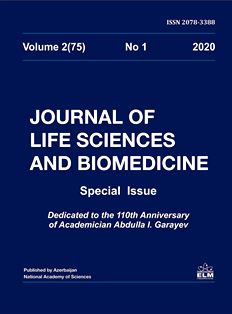
Nanomedicine for ophthalmology: potential therapeutic approaches
Nanomedicine for ophthalmology: potential therapeutic approache
Aziz Eftekhari, Rovshan Khalilov, Irada Huseynova pdf 10.5281/zenodo.8004152
Department of Biochemistry, Faculty of Science, Ege University, 35040, Izmir, Türkiye
Institute of Molecular Biology & Biotechnologies, Ministry of Science and Education of the Republic of Azerbaijan, 11 Izzat Nabiyev Str., AZ1073, Baku, Azerbaijan
Department of Biophysics and Biochemistry, Baku State University, 23 Academician Zahid Khalilov Str., AZ1148, Baku, Azerbaijan
Presidium of Azerbaijan National Academy of Sciences, 30 Istiglaliyyat Str., AZ1001, Baku, Azerbaijan 10.5281/zenodo.8004152
For correspondence: eftekhari.aziz@gmail.com; hrovshan@hotmail.com; irada.huseynova@science.az
Received: March 1, 2023; Received in revised form: March 17, 2023; Accepted: March 27, 2023
Abstract:
The study of nanotechnology has ushered in a new era in medical science in recent years. The term ‘nano’ refers to the nanoscale particle spectrum that includes cellular and molecular structures and is usually between 10 and 1,000 nm in size. Nanoparticles have several advantages over conventional ophthalmic medications including abilities of smart drug targeting; extended drug release time; have reduced toxic effects; and use of gene therapy. After a quick introduction to nanoparticle classification, we'll concentrate on the potential uses of various nanoparticles in the treatment and detection of various retinal pathologies and present cutting-edge nano-derived methodologies.
Keywords: Nanoparticles, ocular disease, drug delivery, medicine
References
Abd A.J., Kanwar R.K., Pathak Y.V., Al Mohammedawi M., Kanwar J.R. (2018) Nanomedicine-based delivery to the posterior segment of the eye: Brighter tomorrow. Drug Delivery for the Retina and Posterior Segment Disease, 195-212.
Betzer O., Chemla Y., Markus A., Motiei M., Sadan T., Liu Z., Mandel Y., Popovtzer R., Fixler D. (2020) Multimodal high-resolution imaging of photoreceptor precursor cells using gold nanoparticles. Nanoscale Imaging, Sensing, and Actuation for Biomedical Applications, XVII, SPIE.
Bhuwane N., Choudhary I., Ramkar S., Hemnani N., Sah A.K., Suresh P. K. (2022) Macrophage targeting for therapy of intraocular diseases. macrophage targeted delivery systems: Basic concepts and therapeutic applications. Springer: 415-436.
Bigdeli A., Makhmalzadeh B. S., Feghhi M., Soleimani Biatiani E. (2023) Cationic liposomes as promising vehicles for timolol/brimonidine combination ocular delivery in glaucoma: formulation development and in vitro/in vivo evaluation. Drug Delivery and Translational Research, 13(4): 1035-1047.
Chang Y.-F., Cheng Y.-H., Ko Y.-C., Chiou S.-H., Liu C. J.-L. (2022) Development of topical chitosan/β-glycerophosphate-based hydrogel loaded with levofloxacin in the treatment of keratitis: An ex-vivo study. Heliyon, 8(1): e08697.
Chaudhary R., Mishra R. (2022) Nano-formulations: Recent trends for ocular bioavailability enhancement. Journal of Drug Delivery and Therapeutics, 12(2-S): 225-233.
Di Iorio E., Barbaro V., Alvisi G., Trevisan M., Ferrari S., Masi G., Nespeca P., Ghassabian H., Ponzin D., Palu G. (2019) New frontiers of corneal gene therapy. Human Gene Therapy, 30(8): 923-945.
Dougherty A.C., Cai W., Hong H. (2015) Applications of aptamers in targeted imaging: State of the art. Current Topics in Medicinal Chemistry, 15(12): 1138-1152.
Giannaccini M., Pedicini L., De Matienzo G., Chiellini F., Dente L., Raffa V. (2017) Magnetic nanoparticles: a strategy to target the choroidal layer in the posterior segment of the eye. Scientific reports7(1): 1-11.
Hainfeld J., Slatkin D., Focella T., Smilowitz H. (2006) Gold nanoparticles: a new X-ray contrast agent. The British Journal of Radiology, 79(939): 248-253.
Haritoglou C., Kernt M., Laubichler P., Langhals H., Eibl K., Varja A., Thaler S., Kampik A. (2012) Synthesis, staining properties and biocompatibility of a new cyanine dye for ILM peeling. Graefe's Archive for Clinical and Experimental Ophthalmology, 250: 829-838.
Heald C., Stolnik S., Kujawinski K., De Matteis C., Garnett M., Illum L., Davis S., Purkiss S., Barlow R., Gellert P. (2002) Poly (lactic acid)- poly (ethylene oxide) (PLA-PEG) nanoparticles: NMR studies of the central solidlike PLA core and the liquid PEG corona. Langmuir, 18(9): 3669-3675.
Hunt N.C., Hallam D., Chichagova V., Steel D.H., Lako M. (2018) The application of biomaterials to tissue engineering neural retina and retinal pigment epithelium. Advanced healthcare materials, 7(23): 1800226.
Kamaleddin M.A. (2017) Nano-ophthalmology: Applications and considerations. Nanomedicine: Nanotechnology, Biology and Medicine, 13(4): 1459-1472.
Kanazawa T., Sugawara K., Tanaka K., Horiuchi S., Takashima Y., Okada H. (2012) Suppression of tumor growth by systemic delivery of anti-VEGF siRNA with cell-penetrating peptide-modified MPEG–PCL nanomicelles. European Journal of Pharmaceutics and Biopharmaceutics, 81(3): 470-477.
Karamichos D. (2015) Ocular tissue engineering: current and future directions, MDPI, 6: 77-80.
Khiev D., Mohamed Z.A.,. Vichare R, Paulson R., Bhatia S., Mohapatra S., Lobo G.P., Valapala M., Kerur N., Passaglia C.L. (2021) Emerging nano-formulations and nanomedicines applications for ocular drug delivery. Nanomaterials, 11(1): 173.
Kim M., Iezzi R.Jr., Shim B.S., Martin D.C. (2019) Impedimetric biosensors for detecting vascular endothelial growth factor (VEGF) based on poly (3, 4-ethylene dioxythiophene) (PEDOT) /gold nanoparticle (Au NP) composites. Frontiers in Chemistry, 7: 234.
Lohia A., Sahel D.K., Salman M., Singh V., Mariappan I., Mittal A., Chitkara D. (2022) Delivery strategies for CRISPR/Cas genome editing tool for retinal dystrophies: challenges and opportunities. Asian Journal of Pharmaceutical Sciences, 17(2): 153-176.
Masse F., Ouellette M., Lamoureux G., Boisselier E. (2019) Gold nanoparticles in ophthalmology. Medicinal Research Reviews, 39(1): 302-327.
Paulus Y.M., Nguyen V.P., Qian W., Li Y., Liu B., Aaberg M., Henry J., Zhang W., Wang X. (2020) Multimodal photoacoustic microscopy and OCT molecular imaging of choroidal neovascularization using chain-like gold nanoparticles. Investigative Ophthalmology & Visual Science, 61(7): 3496-3496.
Qin C., Wen S., Zhu S., Liu D., Chen S., Qie J., Chen H., Lin Q. (2020) Are poly (amidoamine) dendrimers safe for ocular applications? Toxicological evaluation in ocular cells and tissues. Journal of Ocular Pharmacology and Therapeutics, 36(10): 715-724.
Romanowski E.G., Stella N.A., Brothers K.M., Yates K.A., Funderburgh M.L., Funderburgh J.L., Gupta S., Dharani S., Kadouri D.E., Shanks R.M. (2016) Predatory bacteria are nontoxic to the rabbit ocular surface. Scientific Reports, 6(1): 30987.
Sharma R., Sharma D., Hazlett L.D., Singh N.K. (2021) Nano-biomaterials for retinal regeneration. Nanomaterials, 11(8): 1880.
Shen T., Wu Y., Cai W., Jin H., Yu D., Yang Q., Zhu W., Yu J. (2022) LncRNA Meg3 knockdown reduces corneal neovascularization and VEGF-induced vascular endothelial angiogenesis via SDF-1/CXCR4 and Smad2/3 pathway. Experimental Eye Research, 222: 109166.
Singh R.K., Occelli L.M., Binette F., Petersen-Jones S.M., Nasonkin I.O. (2019) Transplantation of human embryonic stem cell-derived retinal tissue in the subretinal space of the cat eye. Stem Cells and Developmen, 28(17): 1151-1166.
Swaminathan, S., Vavia P.R., Trotta F., Cavalli R. (2013) Nanosponges encapsulating dexamethasone for ocular delivery: formulation design, physicochemical characterization, safety and corneal permeability assessment. Journal of Biomedical Nanotechnology, 9(6): 998-1007.
Swetledge S., Jung J.P., Carter R., Sabliov C. (2021) Distribution of polymeric nanoparticles in the eye: implications in ocular disease therapy. Journal of Nanobiotechnology, 19(1): 1-19.
Tam A.L., Gupta N., Zhang Z., Yücel Y.H. (2011) Quantum dots trace lymphatic drainage from the mouse eye. Nanotechnology, 22(42): 425101.
Terreni E., Chetoni P., Burgalassi S., Tampucci S., Zucchetti E., Chipala E., Alany R.G., Al-Kinani A.A., Monti D. (2021) A hybrid ocular delivery system of cyclosporine-A comprising nanomicelle-laden polymeric inserts with improved efficacy and tolerability. Biomaterials Science, 9(24): 8235-8248.
Wang C., Pang Y. (2023) Nano-based eye drop: topical and noninvasive therapy for ocular diseases. Advanced Drug Delivery Reviews, 194: 114721.
Wang C.-H., Wang W.-T., Hsiue G.-H. (2009) Development of polyion complex micelles for encapsulating and delivering amphotericin B. Biomaterials, 30(19): 3352-3358.
Wang J., Li B., Huang D., Norat P., Grannonico M., Cooper R.C., Gui Q., Chow W.N., Liu X., Yang H. (2021) Nano-in-Nano dendrimer gel particles for efficient topical delivery of antiglaucoma drugs into the eye. Chemical Engineering Journal, 425: 130498.
Wei C., Wang Y., Ma L., Wang X., Chi H., Zhang S., Liu T., Li Z., Xiang D., Dong Y. (2018) Rapamycin nano-micelle ophthalmic solution reduces corneal allograft rejection by potentiating myeloid-derived suppressor cells' function. Frontiers in Immunology, 9: 2283.
Wielgus A.R., Zhao B., Chignell C.F., Hu D.-N., Roberts J.E. (2010) Phototoxicity and cytotoxicity of fullerol in human retinal pigment epithelial cells. Toxicology and Applied Pharmacology, 242(1): 79-90.
Wu T., Tang M. (2018) The inflammatory response to silver and titanium dioxide nanoparticles in the central nervous system. Nanomedicine, 13(2): 233-249.
Xu J., Wang Y., Li Y., Yang X., Zhang P., Hou H., Shi Y., Song C. (2007) Inhibitory efficacy of intravitreal dexamethasone acetate-loaded PLGA nanoparticles on choroidal neovascularization in a laser-induced rat model. Journal of Ocular Pharmacology and Therapeutic, 23(6): 527-540.
Zhang C., Wang Y., Wu H., Zhang Z., Cai Y., Hou H., Zhao W., Yang X., Ma J. (2010) Inhibitory efficacy of hypoxia-inducible factor 1α short hairpin RNA plasmid DNA-loaded poly (D, L-lactide-co-glycolide) nanoparticles on choroidal neovascularization in a laser-induced rat model. Gene Therapy, 17(3): 338-351.






















